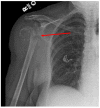An Unusual Presentation of Multiple Myeloma: A 71-Year-Old Female With a Single Lytic Lesion of Her Appendicular Skeleton
- PMID: 35673306
- PMCID: PMC9165616
- DOI: 10.7759/cureus.24725
An Unusual Presentation of Multiple Myeloma: A 71-Year-Old Female With a Single Lytic Lesion of Her Appendicular Skeleton
Abstract
Multiple myeloma is a devastating illness with a hallmark of end-organ damage. The clinical presentation of multiple myeloma often includes the involvement of CRAB (hypercalcemia, renal failure, anemia, bone lesions) symptoms. We present a case of a patient who did not exhibit the typical presentation of multiple myeloma making her case unique and her diagnosis more difficult. In addition to the CRAB criteria, typical symptomatology includes constipation, pain, fatigue, and peripheral sensory issues. The purpose of this case report is to bring awareness to both multiple myeloma and this particular presentation. The patient is a 71-year-old female with a past medical history of hypertension, hypothyroidism, and rheumatoid arthritis who presented with a chief complaint of right shoulder pain. The patient's initial labs were significant for a total protein of 9.3, albumin of 3.4, corrected calcium of 9.3, hemoglobin 10.6 (with baseline near 11-12), and creatinine of 1.0 (baseline of 1.0). The patient's right upper extremity X-rays were significant for a right humeral fracture. The patient had a serum kappa/lambda ratio of 15.94. Bone marrow biopsy revealed 50% kappa-restricted cells, consistent with a diagnosis of multiple myeloma. The patient's subsequent bone survey and CT scan were negative for any additional lesions. The patient had subsequent radiation therapy followed by maintenance therapy with bortezomib, lenalidomide, and dexamethasone with improvement in her symptoms. MM is a complex pathophysiological disease and equally as complex in diagnosis as the presentation is varied and sometimes obscure as noted in the case presented here. Although bone lytic lesions are part of the CRAB criteria, it is rare for them to present in patients with MM in an isolated manner with no corresponding lab abnormalities. With this case, we aim to shed light upon an atypical presentation of MM, notably one that solely involves a pathological fracture in a non-axial distribution.
Keywords: crab; diagnosis of multiple myeloma; pathologic fracture; rank and rankl; solitary lytic lesion.
Copyright © 2022, Khalyfa et al.
Conflict of interest statement
The authors have declared that no competing interests exist.
Figures
Similar articles
-
Chemotherapy May Obviate Prophylactic Femoral Nail Surgery for Multiple Myeloma Patients With High Mirels' Score Lesions and Impending Pathological Hip Fracture.Cureus. 2023 Apr 17;15(4):e37670. doi: 10.7759/cureus.37670. eCollection 2023 Apr. Cureus. 2023. PMID: 37206489 Free PMC article.
-
A Case Report of the Atypical Presentation of Multiple Myeloma Manifesting as a Sternal Mass.Cureus. 2024 Jul 20;16(7):e65004. doi: 10.7759/cureus.65004. eCollection 2024 Jul. Cureus. 2024. PMID: 39165445 Free PMC article.
-
Acute Kidney Injury in a 31-year-old Male as a Consequence of Multiple Myeloma.Cureus. 2018 Jun 26;10(6):e2881. doi: 10.7759/cureus.2881. Cureus. 2018. PMID: 30155383 Free PMC article.
-
Treatment approach for the older, unfit patient with myeloma from diagnosis to relapse: perspectives of a European hematologist.Hematology Am Soc Hematol Educ Program. 2018 Nov 30;2018(1):83-87. doi: 10.1182/asheducation-2018.1.83. Hematology Am Soc Hematol Educ Program. 2018. PMID: 30504295 Free PMC article. Review.
-
Approach to the treatment of the older, unfit patient with myeloma from diagnosis to relapse: perspectives of a US hematologist and a geriatric hematologist.Hematology Am Soc Hematol Educ Program. 2018 Nov 30;2018(1):88-96. doi: 10.1182/asheducation-2018.1.88. Hematology Am Soc Hematol Educ Program. 2018. PMID: 30504296 Free PMC article. Review.
References
-
- Monoclonal gammopathy of undetermined significance (MGUS) consistently precedes multiple myeloma: a prospective study. Landgren O, Kyle RA, Pfeiffer RM, et al. http://10.1182/blood-2008-12-194241. Blood. 2009;113:5412–5417. - PMC - PubMed
-
- Fracture risk with multiple myeloma: a population-based study. Melton LJ 3rd, Kyle RA, Achenbach SJ, Oberg AL, Rajkumar SV. J Bone Miner Res. 2005;20:487–493. - PubMed
Publication types
LinkOut - more resources
Full Text Sources
Miscellaneous

